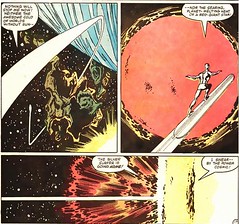Johnald's Fantastical Daily Link Splurge |
- Despite iPods and Walkmen, Rates of Hearing Loss Dropping
- NASA Listens for Sign Mars Phoenix Survived Winter
- star [Flickr]
- baris-gurbuz-6 [Flickr]
- Ben-Hattenbach1_1383888i [Flickr]
- Akhmetsafin-Ruslan_1383897i [Flickr]
- Epic_by_casperium [Flickr]
| Despite iPods and Walkmen, Rates of Hearing Loss Dropping Posted: 15 Jan 2010 03:42 PM PST
Despite all the Walkmen, boomboxes, 8-tracks, iPods and Bluetooth headsets that have delivered raucous noise to the ears of Baby Boomers, hearing loss appears to be declining among adults. This counterintuitive finding from the first study of long-term changes in hearing loss is that for every five years a man or woman was born later in the 20th century, their chance of having hearing impairment dropped 13 percent and 6 percent, respectively. A key suggestion of the report is that other, positive changes in the last 50 years — reduced noise levels at work and better overall health — are more important than the rise of headphones and other entertainingly noisy new products. "Because many people think that the world is getting noisier and noisier, they think that the prevalence of hearing impairment might increase," said Weihai Zhan, a population health scientist at the University of Wisconsin, Madison. "But the prevalence of hearing impairment is decreasing across the generation." The new work draws on a long-term study of health outcomes for the people of Beaver Dam, Wisconsin, a small town in between Milwaukee and Madison. More than 2,000 people underwent three health screenings at five-year intervals. The study also underscores that hearing loss clearly is not wholly determined by genetic factors or simple aging, but rather stems from several "environmental, lifestyle or other modifiable factors," the authors wrote in their new paper in the American Journal of Epidemiology January issue. Image: ElDave/Flickr See Also:
WiSci 2.0: Alexis Madrigal's Twitter, Google Reader feed, and green tech history research site; Wired Science on Twitter and Facebook. |
| NASA Listens for Sign Mars Phoenix Survived Winter Posted: 15 Jan 2010 12:10 PM PST
NASA will attempt to reestablish contact with the Mars Phoenix Lander on Monday. The Mars Odyssey orbiter will pass over the lander's position (highlighted in the image above) 10 times a day for three straight days, listening for any sign that the craft survived the Martian winter's freezing temperatures. Phoenix's electronics weren't designed to live through the period, so NASA officials aren't hopeful that they'll hear anything. "We do not expect Phoenix to have survived, and therefore do not expect to hear from it. However, if Phoenix is transmitting, Odyssey will hear it," said Chad Edwards, chief telecommunications engineer for the Mars Exploration Program at the Jet Propulsion Laboratory, in a press release. "We will perform a sufficient number of Odyssey contact attempts that if we don't detect a transmission from Phoenix, we can have a high degree of confidence that the lander is not active." In the unlikely case the Phoenix rises from the
Mars Phoenix (aka @MarsPhoenix) was a wildly popular robotic lander that operated on the surface of the Red Planet for five months until November 2008 when its solar panels stopped receiving enough energy to keep it working. Since then, it's been through the Martian winter and part of the spring. The amount of solar energy hitting its high-latitude location is now roughly the same as it was when it shut down. If Odyssey doesn't hear anything next week, further attempts to establish contact with Phoenix will come in February or March, when Odyssey will actively try to transmit radio signals to the lander instead of just listening. We imagine the message will be something like, "Hey, little buddy, you there?" In the meantime, we can only assume that Mars Phoenix is gone, but not forgotten. As the first NASA mission to make meaningful use of Twitter to engage the public, the craft earned a special, sub-140 character epitaph in our Twitter Epitaph Contest: Veni, vidi, fodi. (I came, I saw, I dug) See Also:
WiSci 2.0: Alexis Madrigal's Twitter, Google Reader feed, and green tech history research site; Wired Science on Twitter and Facebook. |
| Posted: 08 May 2009 05:35 PM PDT johnald_chaffinch posted a photo: This posting includes an audio/video/photo media file: Download Now |
| Posted: 20 Apr 2009 11:32 PM PDT johnald_chaffinch posted a photo: This posting includes an audio/video/photo media file: Download Now |
| Ben-Hattenbach1_1383888i [Flickr] Posted: 17 Apr 2009 02:17 AM PDT johnald_chaffinch posted a photo: This posting includes an audio/video/photo media file: Download Now |
| Akhmetsafin-Ruslan_1383897i [Flickr] Posted: 17 Apr 2009 02:17 AM PDT johnald_chaffinch posted a photo: This posting includes an audio/video/photo media file: Download Now |
| Posted: 17 Apr 2009 02:17 AM PDT johnald_chaffinch posted a photo: This posting includes an audio/video/photo media file: Download Now |
| You are subscribed to email updates from Johnus Morphopalus's Facebook notes To stop receiving these emails, you may unsubscribe now. | Email delivery powered by Google |
| Google Inc., 20 West Kinzie, Chicago IL USA 60610 | |









No comments:
Post a Comment